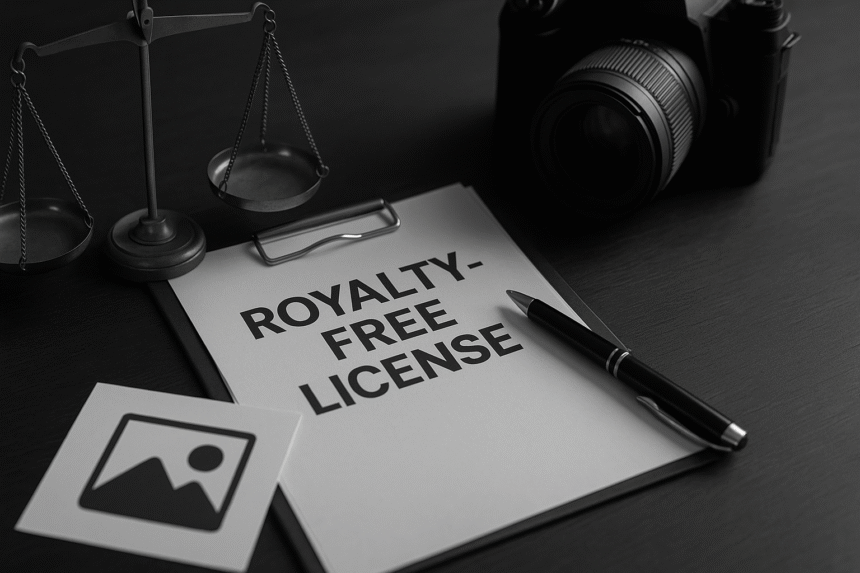The Ultimate Guide to Royalty-Free Licenses: Definition and Legal Examples Explained
Quick Answer
A royalty-free license is a type of legal agreement that grants the buyer permission to use copyrighted content, such as images, music, software, or video, without the obligation to pay recurring royalties or per-use fees. Instead, the user typically pays a one-time licensing fee to access and use the content under clearly defined terms.
This licensing model is a cornerstone of commercial content licensing, especially for businesses that rely on visual, audio, or software assets across multiple campaigns, platforms, or client deliverables. It offers predictable costs and operational flexibility, making it a popular choice for companies managing high content output.
For early-stage ventures, understanding how a royalty free license works is also essential for intellectual property compliance for startups. Using unlicensed or improperly licensed materials can expose a company to legal risk, fines, or brand reputation issues. Royalty-free licenses offer a safer, structured alternative for legally acquiring content in a scalable, business-friendly way.
Breaking Down the Definition
A royalty free license does not mean the content is free of charge—it simply means that you pay a single upfront fee to use the content, rather than paying for each individual use. This structure is particularly valuable in commercial content licensing, where businesses may need to use the same asset across various platforms, campaigns, or clients.
Here’s what a typical royalty-free license includes:
-
One-time fee: You pay once to obtain the right to use the asset.
-
Multiple-use rights: The content can be reused in multiple projects or formats without additional payment.
-
Defined usage scope: The license outlines how, where, and for how long the content may be used (e.g., web, print, broadcast).
-
Non-exclusive rights: The same content may also be licensed to other users under separate agreements.
It’s important to note that a royalty free license is not the same as “public domain” or “free for commercial use.” While royalty-free content is widely used, it still comes with terms and restrictions—especially relevant to intellectual property compliance for startups. Founders and small teams must ensure they carefully review and adhere to license terms to avoid legal exposure when using digital assets for commercial purposes.
Why It Matters
Royalty-free licenses are foundational to the way creative and digital industries operate today. Whether you’re a SaaS startup, an e-commerce brand, an educator, or a content creator, chances are you’re already relying on royalty free licenses to access stock photos, music, templates, or icons.
Here’s why these licenses matter—especially in the context of commercial content licensing:
-
Cost-effective: By eliminating ongoing royalty payments, royalty-free licenses offer predictable pricing, which is especially beneficial for startups with tight marketing budgets.
-
Saves time: No need to negotiate custom terms for every piece of content; the license typically outlines clear, reusable rights.
-
Reduces legal risk: Using unlicensed content exposes businesses to potential lawsuits, fines, or takedowns. A royalty free license helps support intellectual property compliance for startups, ensuring assets are used legally and responsibly.
In short, royalty-free doesn’t mean risk-free—but when properly understood and applied, it’s one of the most practical tools for growing a brand or product without legal hurdles.
Common Use Cases:
-
Royalty-free licenses are essential in commercial content licensing and are commonly used across various industries and platforms. Typical examples include:
-
Stock photos for websites, blog posts, marketing campaigns, and online ads
-
Background music for YouTube videos, podcasts, and promotional content
-
Icons and illustrations embedded in mobile apps, SaaS dashboards, or branded UI
-
Templates for pitch decks, presentations, reports, or legal documents
For startups and small businesses, ensuring that these assets are properly licensed is a key part of intellectual property compliance for startups—minimizing legal exposure while maximizing brand consistency and professionalism.
-
Legal or Practical Implications
Understanding the fine print of royalty-free licenses is crucial:
Key Legal Considerations:
- Scope of license: Commercial vs. personal use, geographic limitations, time limits.
- Modification rights: Can you edit or adapt the content?
- Distribution limits: Are you allowed to redistribute the content or include it in resalable products?
- Attribution requirements: Some licenses still require credit to the original creator.
Jurisdictional Variations:
- In the U.S. and EU, the definition is broadly similar, but local copyright laws may affect enforcement.
- Some licenses may contain governing law clauses—make sure it aligns with your business location.
Need more understanding on royalty-free licenses?
Example Clause or Use Case
Sample Royalty-Free Clause:
“Subject to the terms of this Agreement, Licensor grants Licensee a worldwide, non-exclusive, royalty-free license to use the Content for commercial and non-commercial purposes, including reproduction, distribution, and public display, without additional payments beyond the initial license fee.”
Real-Life Scenario:
A marketing agency purchases an image from a stock photo platform under a royalty free license. Because the license includes commercial content licensing rights, the agency is legally permitted to reuse the image across a wide range of deliverables—without paying additional fees.
They use the image in:
-
Multiple client ad campaigns
-
Social media graphics
-
A corporate pitch deck presentation
Thanks to the license’s broad terms, all these uses fall under permitted scope. This saves time, reduces cost, and ensures intellectual property compliance for startups and agencies alike. By securing the proper license upfront, the agency avoids potential copyright issues and demonstrates professional licensing standards in its content operations.
Call-to-Action
Still unsure how to use royalty-free content safely in your business? Book a consultation



Leave a Reply